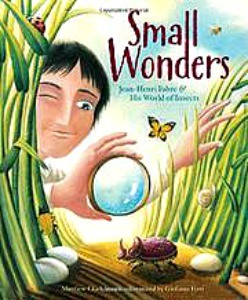
The Horn Book website has lots of material of interest to teachers. Here are some areas to explore. And follow us on Twitter: #lollysclass
|
Interviews with authors and illustrators Recommended books -- reviews and themed book lists |
School -- reading in school, author visits, and more Suggestion box: what else to you want to see in Lolly's Classroom? |
Scientists as dreamers
Can scientists be dreamers? They not only can, but should! The imagination pushes the boundaries of what can be discovered or created.
 Star Stuff: Carl Sagan and the Mysteries of the Cosmos by Stephanie Roth Sisson
Star Stuff: Carl Sagan and the Mysteries of the Cosmos by Stephanie Roth SissonFilled with wonder and imagination, the illustrations in this picture book biography are rendered with watercolors, pencil, and chalk, among other media, to create a memorable look at Sagan’s early life, as a boy in the 1930’s who was fascinated by everything. He was inspired by both the natural and technological world and combined these interests to become an astrophysicist who helped launch the first probes into our solar system, as well as into deep space. Sagan also was a writer and television commentator that brought the wonders of the universe to both the expert and the layman. Sisson writes in a simplistic voice, and concludes the title with additional information on his complex subject, notes of explanation for each page of the book, a short bibliography, and source notes for the included quotations.
 Earmuffs for Everyone: How Chester Greenwood Became Know as the Inventor of Earmuffs by Megan McCarthy
Earmuffs for Everyone: How Chester Greenwood Became Know as the Inventor of Earmuffs by Megan McCarthyTold very much as a story, with direct address to the reader, McCarthy uses her classic style of writing, and bug eyed character illustrations, to tell how Greenwood, in the late 1800’s, made improvements to the previously-designed earmuffs — and also improved other products. Additionally, he and his wife were active in women’s rights. Unfortunately, he died rather young, but his legacy didn’t die with him, as in 1977 Chester Greenwood Day became official in his home state of Maine. Tall tales grew about him, but McCarthy has ferreted out the truth from the legend, as she describes her research strategy in an endnote. Also included: a note about patents and a bibliography.
 Small Wonders: Jean-Henri Fabre & His World of Insects by Matthew Clark Smith, illustrated by Giuliano Ferri
Small Wonders: Jean-Henri Fabre & His World of Insects by Matthew Clark Smith, illustrated by Giuliano FerriIllustrated in dreamy, muted colors that create mystery and mood, and illuminate the setting of the French countryside in the 1800’s, Ferri begins this picture book with a bugs-eye view of Fabre and his work. In a storyteller’s voice, Smith relates the tale of Fabre, the introverted genius, in child appealing description and quotations. Fabre made his life long fascination with insects a world-renowned career. He overcame poverty as a child, the loss of two children, and adult illnesses, but persisted in his studies, earning a doctorate degree for his groundbreaking work with insects. Not always lauded for his controversial observational methods and findings, he persisted in writing poetry and essays with drawings, all aimed at a general audience, of many insects. At 90, he won a Nobel Prize in Literature, presented by the President of France. This exquisite picture book biography concludes with a historical note that more fully explains Fabre’s methods, contributions, and influences on others (including Darwin); a reproduced photograph of Fabre with a hand written note from Darwin; and a timeline, author’s note, and sources.
For recommended biographies of some women scientists, check out Carli Spina's post, "Women in STEM."
RELATED
RECOMMENDED
ALREADY A SUBSCRIBER? LOG IN
We are currently offering this content for free. Sign up now to activate your personal profile, where you can save articles for future viewing.







Add Comment :-
Be the first reader to comment.
Comment Policy:
Comment should not be empty !!!